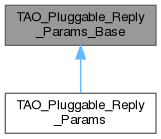TAO_Pluggable_Reply_Params_Base. More...
#include <Pluggable_Messaging_Utils.h>

Public Member Functions | |
| TAO_Pluggable_Reply_Params_Base () | |
| Constructor. | |
| IOP::ServiceContextList & | service_context_notowned () |
| void | service_context_notowned (IOP::ServiceContextList *svc) |
| GIOP::ReplyStatusType | reply_status () const |
| void | reply_status (GIOP::ReplyStatusType status) |
| GIOP::LocateStatusType | locate_reply_status () const |
| void | locate_reply_status (GIOP::LocateStatusType status) |
Public Attributes | |
| IOP::ServiceContextList | svc_ctx_ |
| The IOP service context list. | |
| CORBA::ULong | request_id_ |
| The request id for which the reply we (connector) has received. | |
| CORBA::Boolean | is_dsi_ |
| ptrdiff_t | dsi_nvlist_align_ |
| CORBA::Boolean | argument_flag_ |
Protected Attributes | |
| IOP::ServiceContextList * | service_context_ |
| The service context list that we don't own. | |
Private Attributes | |
| GIOP::ReplyStatusType | reply_status_ |
| The reply status. | |
| GIOP::LocateStatusType | locate_reply_status_ |
| The locate reply status. | |
Detailed Description
TAO_Pluggable_Reply_Params_Base.
This represents a set of data that would be assembled by the acceptor to pass to the connector. This base class is used by TAO_ServerRequest. The child class TAO_Pluggable_Reply_Params is used on the client side, and contains an additional TAO_InputCDR member, not needed on the server side.
Constructor & Destructor Documentation
◆ TAO_Pluggable_Reply_Params_Base()
| TAO_Pluggable_Reply_Params_Base::TAO_Pluggable_Reply_Params_Base | ( | ) |
Constructor.
Member Function Documentation
◆ locate_reply_status() [1/2]
| GIOP::LocateStatusType TAO_Pluggable_Reply_Params_Base::locate_reply_status | ( | ) | const |
◆ locate_reply_status() [2/2]
| void TAO_Pluggable_Reply_Params_Base::locate_reply_status | ( | GIOP::LocateStatusType | status | ) |
◆ reply_status() [1/2]
| GIOP::ReplyStatusType TAO_Pluggable_Reply_Params_Base::reply_status | ( | ) | const |
◆ reply_status() [2/2]
| void TAO_Pluggable_Reply_Params_Base::reply_status | ( | GIOP::ReplyStatusType | status | ) |
◆ service_context_notowned() [1/2]
| IOP::ServiceContextList & TAO_Pluggable_Reply_Params_Base::service_context_notowned | ( | ) |
Get and Set methods for the service context list that we dont own. This is useful for cases where the application objects own a service context list and would like to pass on their contents without a copy.
◆ service_context_notowned() [2/2]
| void TAO_Pluggable_Reply_Params_Base::service_context_notowned | ( | IOP::ServiceContextList * | svc | ) |
Member Data Documentation
◆ argument_flag_
| CORBA::Boolean TAO_Pluggable_Reply_Params_Base::argument_flag_ |
A flag that indicates if there is any data is going to get marshalled in the reply
◆ dsi_nvlist_align_
| ptrdiff_t TAO_Pluggable_Reply_Params_Base::dsi_nvlist_align_ |
Info required for DSI optimization that pads the outgoing CDR stream according to the alignment of the NVList.
◆ is_dsi_
| CORBA::Boolean TAO_Pluggable_Reply_Params_Base::is_dsi_ |
Since this class no longer contains an NVList, this is the way to determine if the request was DSI, so we can use Carlos' service context list no-deep-copy optimization.
◆ locate_reply_status_
|
private |
The locate reply status.
◆ reply_status_
|
private |
The reply status.
◆ request_id_
| CORBA::ULong TAO_Pluggable_Reply_Params_Base::request_id_ |
The request id for which the reply we (connector) has received.
◆ service_context_
|
protected |
The service context list that we don't own.
◆ svc_ctx_
| IOP::ServiceContextList TAO_Pluggable_Reply_Params_Base::svc_ctx_ |
The IOP service context list.
The documentation for this class was generated from the following files: